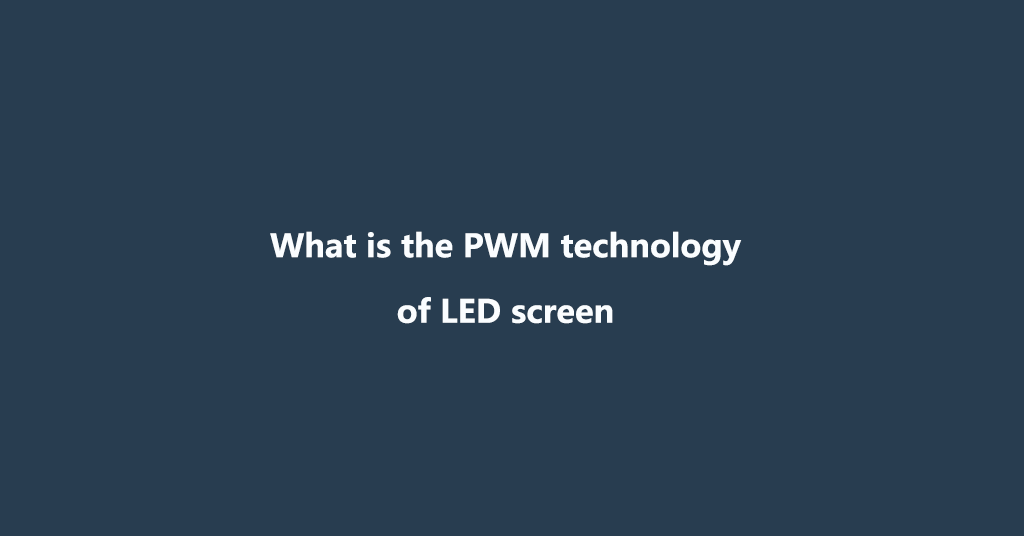What is the PWM technology of LED screen?
At present, LED screens appear more and more frequently in various occasions, and their excellent display effects attract more and more customers to purchase and use them. However, when many people use mobile phones or cameras to shoot LED screens, they are likely to find that the photos taken cannot achieve the effect seen by human eyes. Things like water ripples will appear in the picture. So what’s going on here? Today we will conduct a brief analysis from several places such as refresh rate and gray scale.

Refresh frequency of LED escreen
Refresh frequency” refers to the number of times the screen is updated per second, usually expressed in Hertz (Hz). Generally speaking, the refresh rate is above 3,000Hz, which is a high-performance LED electronic display. The higher the visual refresh rate, the more stable the screen display. The smaller the visual flickering. The low “visual refresh rate” of the LED screen will not only cause horizontal stripes when taking pictures and photography, but also produce images similar to tens of thousands of light bulbs flickering at the same time. When the human eye is watching Discomfort and even damage to the eyes may therefore occur.
Although for the human eye, the visual refresh rate is above 60Hz, it can already experience continuous images, but the higher the visual refresh rate, the more stable the displayed image, and the less likely the human eyes feel fatigued. In today’s high-quality video, in order to obtain more detailed images, such as wonderful playback or close-up photography, high-speed cameras above 1,000 Hz are used for shooting. At this time, for the LED screen that will also be photographed, it is a big challenge to still present continuous images (no black scanning lines) or continuous color gradation under high-speed shutter.

Gray scale of LED screen
“Gray level” refers to the various color levels between the darkest and brightest colors, which have different color levels. Generally speaking, the gray level is above 14 bits, that is, there are at least 16,384 color levels, which is a high-performance LED display. screen. If the number of gray levels is insufficient, there will be a lack of color levels or a gradient color level that is not smooth enough to fully display the color of the film. This will greatly reduce the display effect of the LED screen. Some low-efficiency LED screens Under the shutter speed of 1/500, the distribution of color patches can already be detected. If the shutter speed is increased, such as 1/1,000 or 1/2,000, the unevenness of the gradient color gradation of the LED screen will become more obvious .
Several core components of the LED screen, such as LED switching power supply, LED driver chip, LED lamp beads, etc., directly affect the stability of the display effect of the LED screen. The refresh frequency and gray scale of the LED screen, the LED driver chip directly determines the performance of the LED screen in terms of visual refresh frequency and gray scale.

At present, in the field of LED screen driver chips, the highest and newest technology is “Scrambled PWMS-PWM technology”. S-PWM technology is an improved radical pulse width modulation (PWM technology, which disperses the on-time of an image into several shorter on-times to increase the overall visual update rate.) A new generation of LED driver chips The built-in S-PWM technology can count each frame once. LED grains ONLED grains OFF mode, the average number is broken up into multiple counts, and each broken up equal portion can maintain the original On/Off ratio before being broken up.
S-PWM technology provides different counting modes, so it can increase the image refresh rate up to 64 times. If it is replaced by S-PWM to increase the image refresh rate, only low-order clocks are needed. For example, 5MHz can easily increase the visual refresh rate by 64 times, and can reach more than 4,800Hz. Compared with the general video vision refresh rate, it is at least 10 times higher, and it can also prevent the occurrence of high-frequency electromagnetic interference.
The LED screen equipped with S-PWM driver chip will no longer have horizontal black scanning lines and color patch distribution when using a high-speed shutter of a digital camera to take pictures. Its visual refresh rate and gray scale performance far exceed those of LED screens using radical switch-type driver chips.
Want to know more about the Audio Visual Solutions?
